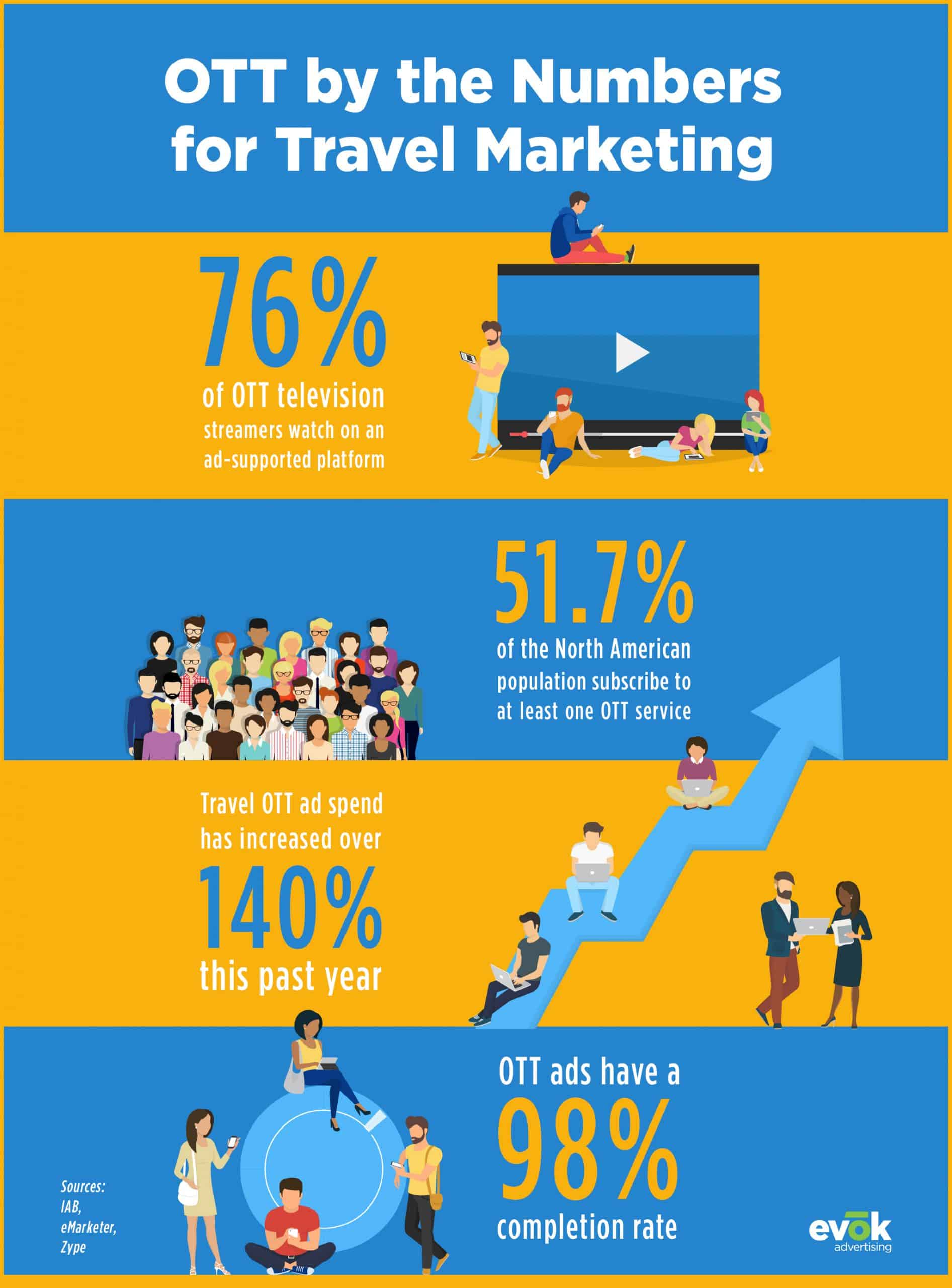
Travel Marketing in 2021: Leaning into OTT and CTV

As travel marketers, OTT and CTV may be the campaign game-changers you have been waiting for. Wanderers, travel-lovers, family adventure-seekers, and globetrotters all spend hours watching television and video, but their viewing habits have changed in recent years. Instead of watching traditional TV, they are now watching their favorite TV shows and movies through CTV and OTT platforms.
If your travel brand has been holding off on creating television advertisements because of the costs and limitations, keep reading to find out if OTT advertising is for you.
What Is OTT and CTV?
OTT, CTV—what do these acronyms mean? Here’s the simple breakdown:
- OTT stands for Over-The-Top services which is any type of video or streaming service that provides viewer access to movies or TV shows directly through the internet. Examples of OTT services include Netflix, Hulu, Disney+, and Amazon Prime.
- CTV stands for Connected TV and refers to any internet-connected device that allows a user to watch OTT content.
What’s the OTT Hype About?
Video streaming platforms, such as Netflix, are on the rise around the world, with 51.7% of the North American population subscribing to at least one OTT service. While services like Netflix and Amazon Prime do not provide much room for advertisements, other services, such as Hulu, provide less expensive subscriptions for users who don’t mind watching commercials during their late-night Grey’s Anatomy binge.
About 76% of OTT television streamers watch on an ad-supported platform. You may be wondering how people are willing to subscribe to a platform where they will be subjected to watching ads when just a few years ago we were all recording our favorite shows to be able to fast forward through the commercials. According to a study conducted by Nielsen, OTT viewers are younger and more affluent compared to traditional cable TV viewers. These younger viewers are so engaged they are willing to watch ads just to have access to their favorite content. In fact, they complete 98% of all video ads that appear on their screens.
So, What Does OTT Mean for the Travel Industry?
Despite COVID-19 still making its way across the globe, research conducted by PWC suggests that 90% of consumers expect to travel again in the next 12 months. Deloitte notes that travel plans are stronger among 18-24-year-olds, and these millennials consumers are heavy streamers of ad-supported CTV and OTT content. Local tourism boards and national parks have taken advantage of this information and have increased OTT ad spend compared to the first week of April in 2020.
Since OTT services all creative content to be hyper-focused to your specific audience, you are able to create advertisements that will draw viewers to want to visit your destination or use your travel organization to make their trip more pleasurable. Say you want travelers to stay at your hotel when they travel to New York City. An OTT user has been researching hotels in New York on Google for their upcoming vacation. When they sit down to watch the latest Bachelor episode on Hulu, they can potentially get your ad (if they meet your target-audience specifications) which may lead to them researching your hotel and booking a room.
OTT and CTV Best Practices: Make Sure Your Ads Stand Out

When it comes to creating OTT content there are few important things you should know before getting started. Follow these best practices and make sure that your ad stands out amongst the competition in the travel industry.
Make Sure Your Video is Sized for Multiple Devices
Don’t assume that your OTT ad will only be shown on a large TV screen. Users may be watching on any device such as a phone, tablet, or laptop, so make sure that your ad can appear across multiple devices. Research sizing recommendations for each device type so that viewers can see and respond to your call to action (CTA).
Take Advantage of A/B testing
Maybe you’re thinking of targeting Gen Z travelers, but you’re not sure which advertising copy and video will resonate with them more. Well, here’s where A/B testing can be a wonderful marketing tool in your belt of strategies. Plan multiple versions of your video and copy so you can run A/B tests on different OTT platforms. Not only will you be able to gather data on what content grabs your target audience’s attention best, but you can use this information to build stronger marketing campaigns in the future.
Well, what if you’re looking to target different audiences with the same product? A/B testing can be beneficial here as well. Take a look at Native’s recent OTT/CTV ad. They altered different creative variables, such as the messaging, to create a video that is relevant to the different audiences they were targeting.
Keep it 30 Seconds or Less
If you’re used to creating advertisements for traditional TV, you’ll have to break some old habits to be successful in the OTT world. You may be used to creating long commercials filled with information, but OTT users don’t respond well to this kind of advertisement during their binge-watching session. Keep your ads short, sweet, and to the point for non-skippable OTT ads (15 to 30 seconds).
Infuse Your Personality
Going along with the last point, not only do OTT viewers expect ads to be shorter, but they also expect them to be entertaining. For example, Cinnamon Toast Crunch launched a mini-game campaign on Roku last year. While their ad is running on the top right of the screen, viewers can use their Roku remote to move a “Crazy Square” around the screen. Once the square reaches a certain place on the screen, another square eats him, in a true Cinnamon Toast fashion. This ensures that the brand stays fresh in the viewer’s mind, and shows off the company’s personality while keeping the user entertained on the screen rather than grabbing their phone.
Another great example of a company that lets its personality shine through an OTT ad while maintaining the viewer’s attention is Hinge. The commercial adds a sense of humor by destroying the cute Hinge pillow as app users fall in love, and their strong call to action beckons viewers to download the app.
The possibilities are endless with OTT and CTV advertising. In such a young market, you can be bold, quirky, and humorous in a way that benefits your travel brand.
Want to hear more from our travel and tourism marketing agency? Sign up for our travel newsletter for monthly insights on how to attract visitors to your destination, how travelers plan their trips, and what’s trending in destination marketing.